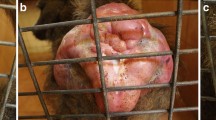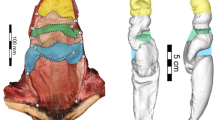Abstract
EVIDENCE from field1–7 and laboratory8–14 studies suggests that the males of several primate species are aware of the endocrine condition of females. While both motor responses and the role of visual cues have received attention, the possibility that olfaction might communicate information about sexual status between consorts has only recently been investigated in microsomatic, higher primates15‐19. Adult male rhesus monkeys will not regularly press a lever for access to ovariectomized partners unless the partners are oestrogenized20. Further, if small amounts of oestradiol are administered directly into the vaginas of ovariectomized females at a time when their male partners have been made anosmic, the males continue to respond to them as though they are anhormonal. Males, however, will begin pressing levers for access to these females as soon as their olfactory acuity is restored. This fact suggested that oestrogen-treated females produce an olfactory pheromone capable of stimulating male sexual interest21. To explore possible sites of production of male-attractant pheromones, we have studied the effects on male behaviour of transferring vaginal secretions between donor and recipient female partners.
This is a preview of subscription content, access via your institution
Access options
Subscribe to this journal
Receive 51 print issues and online access
$199.00 per year
only $3.90 per issue
Buy this article
- Purchase on Springer Link
- Instant access to full article PDF
Prices may be subject to local taxes which are calculated during checkout
Similar content being viewed by others
References
Carpenter, C. R., J. Comp. Psychol., 33, 113 (1941).
Altmann, S. A., J. Mammal., 40, 317 (1959).
Jay, P., in Behavior of Non-Human Primates (edit. by Schrier, A. M., Harlow, H. F., and Stollnitz, F.) (Academic Press, New York, 1965).
Petter, J. J., in Primate Behavior (edit. by DeVore, I.) (Holt, Rinehart and Winston, New York, 1965).
Simonds, P. E., in Primate Behavior (edit. by DeVore, I.) (Holt, Rinehart and Winston, New York, 1965).
Jolly, A., Lemur Behavior (Univ. of Chicago Press, Chicago, 1966).
Lawick-Goodall, J. von, Anim. Behav. Monogr., 1, 220 (1968).
Hooff, J. A. R. van, Symp. Zool Soc., 8, 97 (1962).
Hall, K. R. L., Boelkins, R. C., and Goswell, M. J., Folia Primat., 3, 22 (1965).
Moynihan, M., J. Zool. (Lond.), 150, 77 (1966).
Doyle, G. A., Pelletier, A., and Bekker, T., Folia Primat., 7, 169 (1967).
Epple, G., Folia Primat., 7, 37 (1967).
Latta, J., Hopf, S., and Ploog, D., Primates, 8, 229 (1967).
Evans, C. S., and Goy, R. W., J. Zool. (Lond.), 156, 181 (1968).
Michael, R. P., Herbert, J., and Welegalla, J., J. Endocr., 39, 81 (1967).
Michael, R. P., and Saayman, G., J. Endocrinol., 41, 231 (1968).
Michael, R. P., and Welegalla, J., J. Endocrinol., 41, 407 (1968).
Michael, R. P., Saayman, G., and Zumpe, D., J. Endocrinol., 41, 421 (1968).
Vandenbergh, J. G., Physiol. Behav., 4, 261 (1969).
Michael, R. P., and Keverne, E. B., Nature, 218, 746 (1968).
Michael, R. P., in Proc. Second Internat. Cong. Primat., 1 (edit. by Carpenter, C. R.) (S. Karger, Basel, 1969) (in the press).
Munsell System of Color Notation (2441 N. Calvert St., Baltimore, Md.).
Author information
Authors and Affiliations
Rights and permissions
About this article
Cite this article
MICHAEL, R., KEVERNE, E. Primate Sex Pheromones of Vaginal Origin. Nature 225, 84–85 (1970). https://doi.org/10.1038/225084a0
Received:
Revised:
Issue Date:
DOI: https://doi.org/10.1038/225084a0
This article is cited by
-
Olfactory signals and fertility in olive baboons
Scientific Reports (2021)
-
Testing for Links Between Female Urine Odor and Male Sexual Behaviors in Japanese Macaques (Macaca fuscata)
International Journal of Primatology (2017)
-
Male-Induced Sociosexual Behavior by Vaginal Secretions in Macaca arctoides
International Journal of Primatology (2006)
-
Species preference by infant macaques with controlled social experience
International Journal of Primatology (1990)
-
The effect of female proximity and social interaction on the menstrual cycle of crab-eating monkeys (Macaca fascicularis)
Primates (1986)
Comments
By submitting a comment you agree to abide by our Terms and Community Guidelines. If you find something abusive or that does not comply with our terms or guidelines please flag it as inappropriate.



